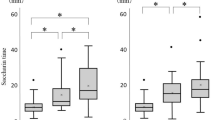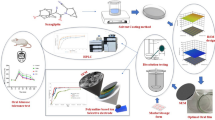Abstract
Purpose
The role of a model hydrophobic phospholipid simulating lining of the gastric mucosa, as to adhesion of polymers with different surface functional groups and surface hydrophobicities, was evaluated using an in vitro gastric mucus model.
Materials and Method
Front-faced fluorescence measurement was used to determine adhesion of fluorescent polystyrene microspheres with different surface functional groups. Contact angle measurements and sticking bubble technique were used to measure relative surface hydrophobicity of the polymers.
Results
Adhesion of fluorescent polystyrene microspheres using front-faced fluorescence measurement revealed the hydrophobic phospholipid lining of the in vitro gastric mucus model did not allow adhesion of microspheres with –COOH and –NH2 functional groups, whereas it did allow adhesion of microspheres with hydrophobic attributes. In addition, in vitro adhesive force studies using diblock copolymers of polystyrene and polyacrylate showed that the in vitro adhesive force between the hydrophobic phospholipid lining of the in vitro gastric mucus model and the polymer increased when the surface hydrophobicity of the polymer increased.
Conclusion
The hydrophobic phospholipid acts as an adhesion barrier to hydrophilic bioadhesive polymers and polymers with surface functional groups of carboxylic acid and amine. The hydrophobic phospholipid lining of the gastric mucosa should be taken into considerations for screening and designing of a new gastric bioadhesive polymer.






Similar content being viewed by others
Abbreviations
- Amine-MS:
-
fluorescent amine-modified polystyrene microspheres
- Carboxylate-MS:
-
fluorescent carboxylate-modified polystyrene microspheres
- F.I.:
-
fluorescence intensity
- IGM:
-
in vitro gastric mucus model without LPC
- IGM-LPC:
-
in vitro gastric mucus model with LPC
- LPC:
-
egg yolk L-α-phosphatidylcholine
- MTS:
-
material testing workstations
- Plain-MS:
-
fluorescent plain polystyrene microspheres
References
H. S. Ch’ng, H. Park, P. Kelly, and J. R. Robinson. Bioadhesive polymers as platforms for oral controlled drug delivery. II. Synthesis and evaluation of some swelling water-insoluble polymers. J. Pharm. Sci. 74:399–405 (1985).
K. Park and J. R. Robinson. Bioadhesive polymers as platforms for oral controlled drug delivery: Method to study bioadhesion. Int. J. Pharm. 19:107–127 (1984).
J. Woodley. Bioadhesion: New possibilities for drug administration? Clin. Pharmacokinet. 40:77–84 (2001).
R. Khosla and S. S. Davis. The effect of polycarbophil on the gastric emptying of pellets. J. Pharm. Pharmacol. 39:47–49 (1987).
D. Harris, J. T. Fell, D. C. Taylor, J. Lynch, and H. L. Sharma. GI transit of potential bioadhesive systems in the rat. J. Control Release 12:55–65 (1990).
J. Lee, J. Park, and J. R. Robinson. Bioadhesive-based on dosage forms: the next generation. J. Pharm. Sci. 89:850–866 (2000).
B. A. Slomiany, A. Piasek, J. Sarosiek, and A. Slomiany. The role of surface intracellular mucus in gastric mucosal protection against hydrogen. Scand. J. Gastroenterol. 20:1191–1196 (1985).
Y. J. Kao and L. M. Lichtenberger. Localization of phospholipid-rich zones in rat gastric mucosa: possible origin of a proactive hydrophobic luminal lining. J. Histochem. Cytochem. 35:1285–1298 (1987).
Y. J. Kao and L. M. Lichtenberger. Ultrastructural evidence that the gastric surface mucous cell (SMC) secretes a surfactant-like phospholipid (SLPL). Gastroenterol. 92:1459 (1987).
B. A. Hills, B. D. Butler, and L. M. Lichtenberger. Gastric mucosal barrier: The hydrophobic lining to the lumen of the stomach. Am. J. Physiol. 244:G561–G568 (1983).
B. A. Hills. A hydrophobic oligolamellar lining to surfaces in various tissues: A possible ubiquitous barrier. Med. Sci. Res. 20:543–550 (1992).
P. J. Goddard, B. A. Hills, and L. M. Lichtenberger. Does aspirin damage canine gastric mucosa by reducing its surface hydrophobicity? Am. J. Physiol. 252:G421–G430 (1987).
P. J. Goddard, Y. J. Kao, and L. M. Lichtenberger. Luminal surface hydrophobicity of canine gastric mucosa is dependent on a surface mucous gel. Gastroenterol. 98:361–370 (1990).
X. Yang. Gastric retentive systems. Master thesis, University of Wisconsin-Madison (1998).
M. D. Lelah, T. G. Grasel, J. A. Pietce, and S. L. Cooper. The measurement of contact angles on circular tubing surfaces using the captive bubble technique. J. Biomed. Mat. Res. 19:1011–1015 (1985).
R. Dierichs and M. Inczedy-Marcsek. Iodoplatinate as a marker of quaternary ammonium compounds in electron microscopy. J. Histochem. Cytochem. 24:962–964 (1976).
G. R. Barlett. Phosphorous assay in column chromatography. J. Biol. Chem. 234:466–468 (1959).
J. T. F. Keurentjes, J. G. Harbrecht, D. Brinkman, J. H. Hanemaaijer, M. A. Cohen Stuart, and K. van’t Riet. Hydrophobicity measurements of microfiltration and ultrafiltration membranes. J. Membr. Sci. 47:333–344 (1989).
T. T. Kararli. Comparision of the gastrointestinal anatomy, physiology, and biochemistry of humans and commonly used laboratory animals. Biopharm. Drug Dispos. 16:351–380 (1995).
Y. J. Kao, P. J. Goddard, and L. M. Lichtenberger. Morphological effects of aspirin and prostaglandin on the canine gastric mucosal surface. Gastroenterol. 98:592–606 (1990).
M. G. J. Schmitz and W. Renooij. Phospholipids from rat, human, and canine gastric mucosa. Gastroenterol. 99:1292–1296 (1990).
W. Bernhard, A. O. Postle, M. Linck, and K. F. Sewing. Composition of phospholipid classes and phosphatidylcholine molecular species of gastric mucosa and mucus. Biochim. Biophys. Acta 1255:99–104 (1995).
D. A. Norris and P. J. Sinko. Effect of size, surface charge, and hydrophobicity on the translocation of polystyrene microspheres through gastrointestinal mucin. J. Appl. Polym. Sci. 63:1481–1492 (1997).
J. Sarosiek, A. Slomiany, and B. A. Slomiany. Retardation of hydrogen ion diffusion by gastric mucus constituents: Effect of proteolysis. Biochem. Biophys. Res. Commun. 115:1053–1060 (1983).
J. Sarosiek and A. Slomiany. Hydrogen ion diffusion in dog gastric mucus glycoprotein: effect of associated lipids and covalently bound fatty acids. Biochem. Biophys. Res. Commun. 118:523–531 (1984).
S. E. Williams and L. A. Turnberg. Retardation of acid diffusion by pig gastric mucus: A potential role in mucosal protection. Gastroenterol. 79:299–304 (1980).
P. M. Goggin, T. C. Northfield, and R. T. Spychal. Factors affecting gastric mucosal hydrophobicity in man. Scand. J. Gastroenterol. 26:65–73 (1991).
R. T. Spychal, J. M. Marrero, S. H. Saverymuttu, and T. C. Northfield. Measurement of the surface Hydrophobicity of human gastrointestinal mucosa. Gastroenterol. 97:104–111 (1989).
B. A. Slomiany, J. Sarosiek, Y. H. Liau, W. Laszewicz, and A. Slomiany. Lysolecithin affects the viscosity, permeability, and peptic susceptibility of gastric mucin. Scand. J. Gastroenterol. 21:1073–1079 (1986).
Acknowledgments
The authors would like to thank Jason Sims and Jennifer Loeb, School of Pharmacy, University of Wisconsin-Madison, USA, for kindly providing the pig stomachs, and Randall Massey for his help on the morphological study of the pig gastric mucosal surface.
Author information
Authors and Affiliations
Corresponding author
Rights and permissions
About this article
Cite this article
Park, J.H., Robinson, J.R. Effect of a Hydrophobic Phospholipid Lining of the Gastric Mucosa in Bioadhesion. Pharm Res 25, 16–24 (2008). https://doi.org/10.1007/s11095-007-9353-x
Received:
Accepted:
Published:
Issue Date:
DOI: https://doi.org/10.1007/s11095-007-9353-x




